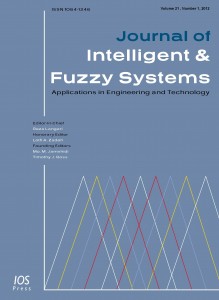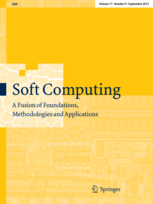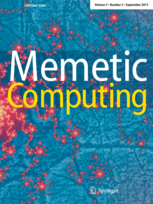Last papers of the Group about Evolutionary Trading Systems Research
 A hybrid automated trading system based on multi-objective grammatical evolution – Journal of Intelligent and Fuzzy Systems.
A hybrid automated trading system based on multi-objective grammatical evolution – Journal of Intelligent and Fuzzy Systems.
This paper describes a hybrid automated trading system (ATS) based on grammatical evolution and microeconomic analysis. The proposed system takes advantage from the flexibility of grammars for introducing and testing novel characteristics. The ATS introduces the self-generation of new technical indicators and multi-strategies for stopping unforeseen losses. Additionally, this work copes with a novel optimization method combining multi-objective optimization with a grammatical evolution methodology. We implemented the ATS testing three different fitness functions under three mono-objective approaches and also two multi-objective ATSs. Experimental results test and compare them to the Buy and Hold strategy and a previous approach, beating both in returns and in number of positive operations. In particular, the multi-objective approach demonstrated returns up to 20% in very volatile periods, proving that the combination of fitness functions is beneficial for the ATS.
 A parallel evolutionary algorithm for technical market indicators optimization – Natural Computing
A parallel evolutionary algorithm for technical market indicators optimization – Natural Computing
This paper deals with the optimization of parameters of technical indicators for stock market investment. Price prediction is a problem of great complexity and, usually, some technical indicators are used to predict market trends. The main difficulty in using technical indicators lies in deciding a set of parameter values. We proposed the use of Multi-Objective Evolutionary Algorithms (MOEAs) to obtain the best parameter values belonging to a collection of indicators that will help in the buying and selling of shares. The experimental results indicate that our MOEA offers a solution to the problem by obtaining results that improve those obtained through technical indicators with standard parameters. In order to reduce execution time is necessary to parallelize the executions. Parallelization results show that distributing the workload of indicators in multiple processors to improve performance is recommended. This parallelization has been performed taking advantage of the idle time in a corporate technology infrastructure. We have configured a small parallel grid using the students Labs of a Computer Science University College.
 Combining Technical Analysis and Grammatical Evolution in a Trading System – EvoApplications 2013
Combining Technical Analysis and Grammatical Evolution in a Trading System – EvoApplications 2013
Trading Systems are beneficial for financial investments due to the complexity of nowadays markets. On one hand, finance markets are influenced by a great amount of factors of different sources such as government policies, natural disasters, international trade, political factors etc. On the other hand, traders, brokers or practitioners in general could be affected by human emotions, so their behaviour in the stock market becomes nonobjective. The high pressure induced by handling a large volume of money is the main reason of the so-called market psychology. Trading systems are able to avoid a great amount of these factors, allowing investors to abstract the complex flow of information and the emotions related to the investments. In this paper we compare two trading systems based on Evolutionary Computation. The first is a GA-based one and was already proposed and tested with data from 2006. The second one is a grammatical evolution approach which uses a new evaluation method. Experimental results show that the later outperforms the GA approach with a set of selected companies of the spanish market with 2012 data.
 A GA Combining Technical and Fundamental Analysis for Trading the Stock Market – EvoApplications 2012
A GA Combining Technical and Fundamental Analysis for Trading the Stock Market – EvoApplications 2012
Nowadays, there are two types of financial analysis oriented to design trading systems: fundamental and technical. Fundamental analysis consists in the study of all information (both financial and nonfinancial) available on the market, with the aim of carrying out efficient investments. By contrast, technical analysis works under the assumption that when we analyze the price action in a specific market, we are (indirectly) analyzing all the factors related to the market. In this paper we propose the use of an Evolutionary Algorithm to optimize the parameters of a trading system which combines Fundamental and Technical analysis (indicators). The algorithm takes advantage of a new operator called Filling Operator which avoids problems of premature convergence and reduce the number of evaluations needed. The experimental results are promising, since when the methodology is applied to values of 100 companies in a year, they show a possible return of 830% compared with a 180% of the Buy and Hold strategy.
 Using a GPU-CPU architecture to speed up a GA-based real-time system for trading the stock market – Soft Computing
Using a GPU-CPU architecture to speed up a GA-based real-time system for trading the stock market – Soft Computing
The use of mechanical trading systems allows managing a huge amount of data related to the factors affecting investment performance (macroeconomic variables, company information, industrial indicators, market variables, etc.) while avoiding the psychological reactions of traders when they invest in financial markets. When trading is executed in an intra-daily frequency instead a daily frequency, mechanical trading systems needs to be supported by very powerful engines since the amount of data to deal with grow while the response time required to support trades gets shorter. Numerous studies document the use of genetic algorithms (GAs) as the engine driving mechanical trading systems. The empirical insights provided in this paper demonstrate that the combine use of GA together with a GPU-CPU architecture speeds up enormously the power and search capacity of the GA for this kind of financial applications. Moreover, the parallelization allows us to implement and test previous GA approximations. Regarding the investment results, we can report 870% of profit for the S&P 500 companies in a 10-year time period (1996–2006), when the average profit of the S&P 500 in the same period was 273%.
 A technique for the optimization of the parameters of technical indicators with Multi-Objective Evolutionary Algorithms – 2012 IEEE Congress on Evolutionary Computation (CEC)
A technique for the optimization of the parameters of technical indicators with Multi-Objective Evolutionary Algorithms – 2012 IEEE Congress on Evolutionary Computation (CEC)
Technical indicators (TIs) are used to interpret stock market and to predict market trends. The main difficulty in the use of TIs lies in deciding which their optimal parameter values are in each moment, since constant optimal values do not seem to exist. In this work, the use of Multi-Objective Evolutionary Algorithms (MOEAs) is proposed to obtain the best values of the parameters in order to help to buy and sell shares. Those parameters are applied in real time and belong to a collection of indicators. Unlike other previous approaches, the necessity of repeating the parameter optimization process each time a new data enters the system is justified, searching for the best adjustment of the parameters (and hence the TIs) in every moment. The Moving Averages Convergence-Divergence (MACD) indicator and the Relative Strength Index (RSI) oscillator have been chosen as TIs, so the MOEAs will provide the best parameters to use them on investment decisions. Experiments compare up to nine different configurations with the Buy & Hold strategy (B & H). The obtained results show that the Multi-Objective technique proposed here can greatly improve the results of the B & H strategy even operating daily. This statement is also demonstrated by comparing the results to those previously presented in the literature.
 Optimization of technical indicators in real time with multiobjective evolutionary algorithms – 2012 - 14th annual conference companion on Genetic and evolutionary computation (GECCO)
Optimization of technical indicators in real time with multiobjective evolutionary algorithms – 2012 - 14th annual conference companion on Genetic and evolutionary computation (GECCO)
Technical analysis uses technical indicators to identify changes in market trend. These are composed by a set of parameters and rules, whose values try to determine the future movements of the assets. This paper addresses the optimization of these values depending on the current market, allowing better returns with less risk. The use of Multi-objective Evolutionary Algorithms (MOEAs) is proposed in this work to obtain the best parameter values in real time belonging to a collection of indicators that will help in the buying and selling of shares. Unlike other previous approaches, the necessity of repeating the parameters optimization process each time a new data enters the system is justified, searching for the best adjustment in every moment. This technique can greatly improve the results of Buy & Hold (B & H) strategy even operating daily. This statement will be demonstrated by comparing the results to those presented in the literature.
 Blind optimisation problem instance classification via enhanced universal similarity metric – Memetic Computing
Blind optimisation problem instance classification via enhanced universal similarity metric – Memetic Computing
The ultimate aim of Memetic Computing is the fully autonomous solution to complex optimisation problems. For a while now, the Memetic algorithms literature has been moving in the direction of ever increasing generalisation of optimisers initiated by seminal papers such as Krasnogor and Smith (IEEE Trans 9(5):474–488, 2005; Workshops Proceedings of the 2000 International Genetic and Evolutionary Computation Conference (GECCO2000), 2000), Krasnogor and Gustafson (Advances in nature-inspired computation: the PPSN VII Workshops 16(52), 2002) and followed by related and more recent work such as Ong and Keane (IEEE Trans Evol Comput 8(2):99–110, 2004), Ong et al. (IEEE Comp Int Mag 5(2): 24–31, 2010), Burke et al. (Hyper-heuristics: an emerging direction in modern search technology, 2013). In this recent trend to ever greater generalisation and applicability, the research has focused on selecting (or even evolving), the right search operator(s) to use when tackling a given instance of a fixed problem type (e.g. Euclidean 2D TSP) within a range of optimisation frameworks (Krasnogor, Handbook of natural computation, Springer, Berlin/Heidelberg, 2009). This paper is the first step up the generalisation ladder, where one assumes that the optimiser is given (perhaps by other solvers who do not necessarily know how to deal with a given problem instance) a problem instance to tackle and it must autonomously and without human intervention pre-select which is the likely family class of problems the instance belongs to. In order to do that we propose an Automatic Problem Classifier System able to identify automatically which kind of instance or problem the system is dealing with. We test an innovative approach to the Universal Similarity Metric, as a variant of the normalised compression distance (NCD), to classify different problem instances. This version is based on the management of compression dictionaries. The results obtained are encouraging as we achieve a 96 % average classification success with the studied dataset. We use this results to obtain clasiffications of Investment groups.
 Technical market indicators optimization using evolutionary algorithms – 2008 - 10th annual conference companion on Genetic and evolutionary computation (GECCO)
Technical market indicators optimization using evolutionary algorithms – 2008 - 10th annual conference companion on Genetic and evolutionary computation (GECCO)
Real world stock markets predictions such as stock prices, unpredictability, and stock selection for portfolios, are challenging problems. Technical indicators are applied to interpret stock market trending and investing decision. The main difficulty of an indicator usage is deciding its appropriate parameter values, as number of days of the periods or quantity and kind of indicators. Each stock index, price or volatility series is different among the rest. In this work, Evolutionary Algorithms are proposed to discover correct indicator parameters in trading. In order to check this proposal the Moving Average Convergence-Divergence (MACD) technical indicator has been selected. Preliminary results show that this technique could work well on stock index trending. Indexes are smoother and easier to predict than stock prices. Required future works should include several indicators and additional parameters.
